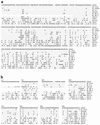Detection and verification of Mycobacterium avium subsp. paratuberculosis in fresh ileocolonic mucosal biopsy specimens from individuals with and without Crohn's disease
- PMID: 12843021
- PMCID: PMC165291
- DOI: 10.1128/JCM.41.7.2915-2923.2003
Detection and verification of Mycobacterium avium subsp. paratuberculosis in fresh ileocolonic mucosal biopsy specimens from individuals with and without Crohn's disease
Abstract
Mycobacterium avium subsp. paratuberculosis is a robust and phenotypically versatile pathogen which causes chronic inflammation of the intestine in many species, including primates. M. avium subsp. paratuberculosis infection is widespread in domestic livestock and is present in retail pasteurized cows' milk in the United Kingdom and, potentially, elsewhere. Water supplies are also at risk. The involvement of M. avium subsp. paratuberculosis in Crohn's disease (CD) in humans has been uncertain because of the substantial difficulties in detecting this pathogen. In its Ziehl-Neelsen staining-negative form, M. avium subsp. paratuberculosis is highly resistant to chemical and enzymatic lysis. The present study describes the development of optimized sample processing and DNA extraction procedures with fresh human intestinal mucosal biopsy specimens which ensure access to M. avium subsp. paratuberculosis DNA and maximize detection of these low-abundance pathogens. Also described are two nested PCR methodologies targeted at IS900, designated IS900[L/AV] and IS900[TJ1-4], which are uniquely specific for IS900. Detection of M. avium subsp. paratuberculosis in mucosal biopsy specimens was also evaluated by using mycobacterial growth indicator tube (MGIT) cultures (Becton Dickinson). IS900[L/AV] PCR detected M. avium subsp. paratuberculosis in 34 of 37 (92%) patients with CD and in 9 of 34 (26%) controls without CD (noninflammatory bowel disease [nIBD] controls) (P = 0.0002; odds ratio = 3.47). M. avium subsp. paratuberculosis was detected by IS900[L/AV] PCR in MGIT cultures after 14 to 88 weeks of incubation in 14 of 33 (42%) CD patients and 3 of 33 (9%) nIBD controls (P = 0.0019; odds ratio = 4.66). Nine of 15 (60%) MGIT cultures of specimens from CD patients incubated for more than 38 weeks were positive for M. avium subsp. paratuberculosis. In each case the identity of IS900 from M. avium subsp. paratuberculosis was verified by amplicon sequencing. The rate of detection of M. avium subsp. paratuberculosis in individuals with CD is highly significant and implicates this chronic enteric pathogen in disease causation.
Figures


References
-
- Borody, T. J., S. Leis, E. F. Warren, and R. Surace. 2002. Treatment of severe Crohn's disease using antimycobacterial triple therapy—approaching a cure? Dig. Liver Dis. 34:29-38. - PubMed
-
- Bull, T. J., J. M. Sheridan, H. Martin, N. Sumar, M. Tizard, and J. Hermon-Taylor. 2000. Further studies on the GS element. A novel mycobacterial insertion sequence (IS1612), inserted into an acetylase gene (mpa) in Mycobacterium avium subsp. silvaticum but not in Mycobacterium avium subsp. paratuberculosis. Vet. Microbiol. 77:453-463. - PubMed
-
- Cabarrocas, J., T. C. Savidge, and R. S. Liblau. 2003. Role of enteric glial cells in inflammatory bowel disease. Glia 41:81-93. - PubMed
-
- Chater, K. F., C. J. Bruton, S. G. Foster, and I. Tobek. 1985. Physical and genetic analysis of IS110, a transposable element of Streptomyces coelicolor A3(2). Mol. Gen. Genet. 200:235-239. - PubMed
Publication types
MeSH terms
Substances
LinkOut - more resources
Full Text Sources
Other Literature Sources
Medical

